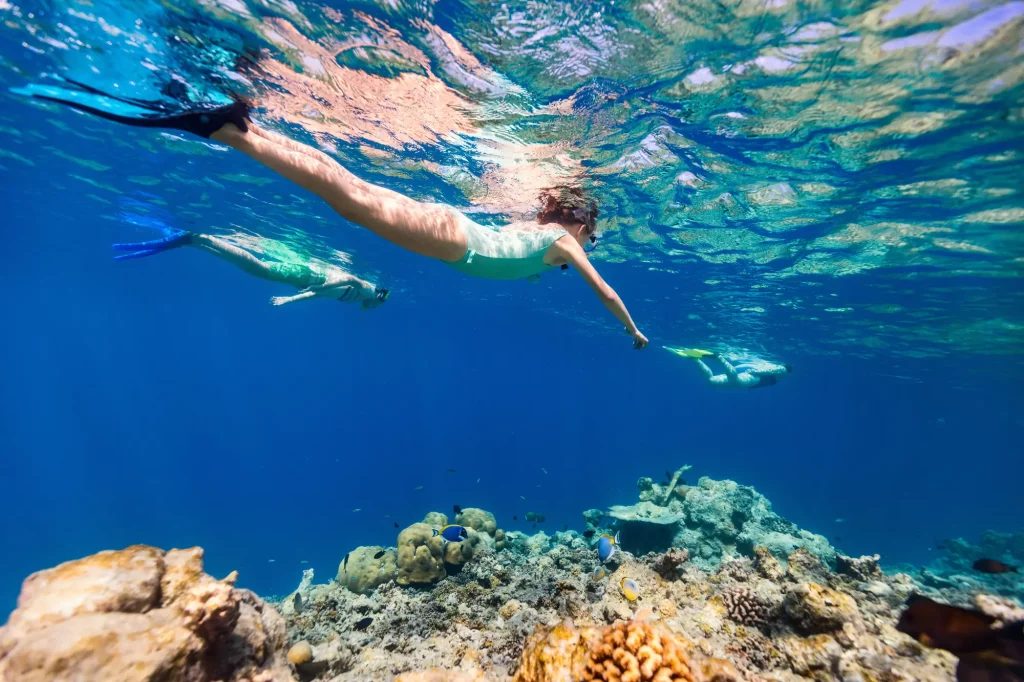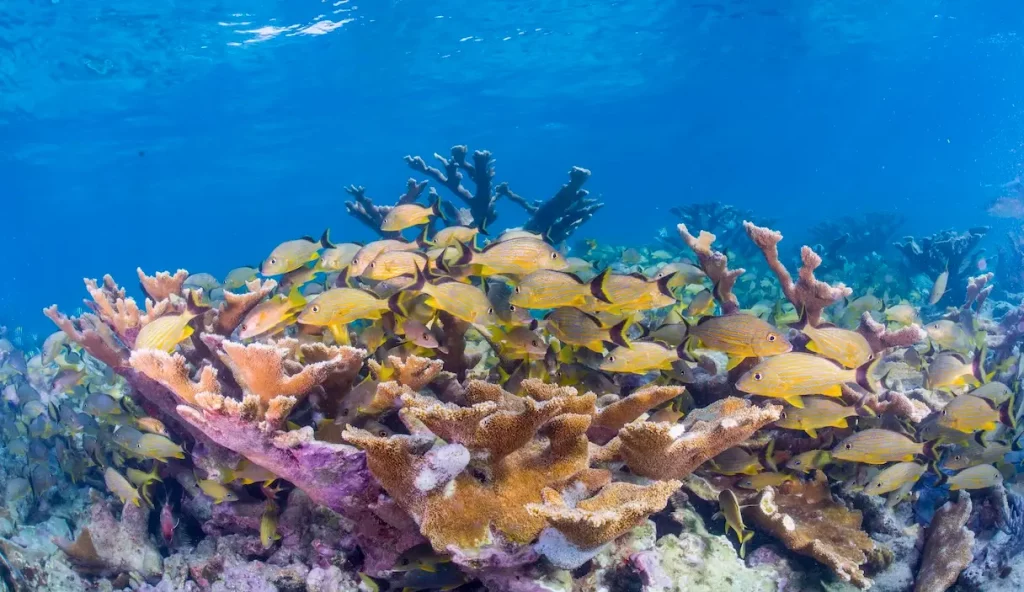
Did you know the Caribbean contains roughly 7000 islands, islets, reefs, and cays?
The Caribbean islands are some of the most popular tourist sites in the world, with a huge part thanks to the underwater wonders surrounding each island. With its various habitats and marine reserves incorporating unique vast biodiversities of fish, invertebrates, and other marine organisms it’s no wonder millions visit the islands each year.
Best Snorkeling Spots In The Caribbean
Whether you’re seeking to find unique marine biodiversity, unique features, or special attractions during your next adventure, there’s bound to be a place guaranteed to meet your needs. Here’s a detailed description of the best snorkeling picks, each with unique features for you to discover.
Grenada’s Underwater Sculpture Park
Grenada is an English-speaking island in the southern Caribbean that contains two sister isles, Carriacou and Petite Martinique and is near Venezuela and Trinidad and Tobago.
Thanks to being relatively untouched, Grenada has preserved much of its natural beauty, making it attractive to snorkelers looking to discover more of the marine biodiversity surrounding the area.
Along with the many coral reefs and respective ecosystems you can visit, one particular snorkeling spot, the Underwater Sculpture Park, stands out due to its many sculptures (75 in fact) stretching over 800 square meters.
Opened in 2006, the Underwater Sculpture Park is the world’s first underwater sculpture park and it now offers guided tours for the divers and snorkelers who visit to see the site and the many marine animals that inhabit the area.
Made of concrete and steel, the 75 sculptures within the park are held to the seafloor via bolts, yet are close enough to the surface that just about any diver, snorkeler, or boat tourists can see them. Not only are they a marvel to look at, but the sculptures also assist in protecting coral reefs by providing places to grow, hence improving the life of the local ecosystems.
Guadeloupe’s Cousteau Marine Reserve
Located within the National Park of Guadeloupe near Malendure Beach in the town of Bouillante, and consisting of roughly 1,000 hectares of seabed in the heart of the Caribbean, the Cousteau Marine Reserve is well known to divers and snorkelers for its extensive fauna and flora. Originally made up of the Pigeon Islands, the marine reserve was chosen to become the heart of the National Park to protect its many ecosystems.
The Cousteau Marine Reserve, named in honor of Oceanographer Jacques Yves Cousteau, is a protected underwater reserve with an abundance of coral reefs and underwater gardens, along with a vast array of tropical fish, sea turtles, lobsters, dolphins, and many other marine animals.
With these spectacles, it is of course important to remember to respect the various habitats and the animals that inhabit them, which is why different diving clubs around the area offer classes to safely explore the reserve. Visitors are encouraged not to disturb the fragile ecosystems in any way, including avoiding stepping or standing on the underwater rocks to avoid harming the microorganisms.
If you do choose to visit via a boat tour, it’s recommended to do so on your own (i.e. by renting a kayak) instead of going on tours since those tend to get quite crowded. It’s also best to go earlier on a sunny day so to avoid the crowds and have the best look at the underwater scenery.

Bonaire
Bonaire is a Dutch island in the Lesser Antilles area within the Caribbean which, along with Aruba and Curaçao, make up the “ABC” islands. Bonaire is a rather small island of roughly 112 square miles.
Bonaire’s capital, Kralendijk, is named after the Dutch word for “coral reef”, due to the island mostly consisting of coral reefs and seagrass beds along the south. To preserve the pristine conditions in and around the island, all waters around and roughly 20% of the landmass on the island are protected.
The abundance of coral reefs is also what makes Bonaire a highly sought-after destination for divers and snorkelers alike. Areas on the island commonly visited by snorkelers include Bari Reef, Lac Bay, and 1,000 Steps.
Bari Reef
Bari Reef has an abundance of coral reefs and accompanying tropical fish that are bound to attract any snorkeler seeking an underwater paradise close to shore. Trumpetfish and bluehead wrasse are especially common.
Visitors are suggested to wear comfortable shoes due to the rocky shores and would need to enter via an adjacent beach.
Lac Bay
A bay with shallow waters and plenty of vibrant corals and fish, Lac Bay is approximately a 15-minute drive from Kralendijk. Staghorn corals are especially prevalent, along with parrotfish, eagle rays, and flounder.
Since the bay is quite shallow, you’ll need to swim out a bit to get the best views of the corals when snorkeling.
1,000 Steps
Named after the plethora of steps one must take to reach the beach (not exactly 1,000 thankfully; only about 50-60), 1,000 Steps is certainly worth the exercise due to the abundance of coral reefs, sponges, and fish found there. The beach is a rough 20-minute drive from Kralendijk.
Water entry is easy, but it is recommended to snorkel with water shoes due to the many corals close to the water surface.
Curaçao’s Tugboat Beach
The last of the “ABC” islands, Curaçao is a long, flat island measuring roughly 180 square miles. Though relatively small, Curaçao has plenty to offer, from visiting its beaches and natural attractions to learning about its rich culture and history. The island also has plenty of snorkeling spots available right offshore so you can easily access them without a boat.
Tugboat Beach is named after a tugboat that was sunk over 30 years ago and can be found roughly 16 feet below the water’s surface. Divers and snorkelers have been eager to explore this shipwreck and the many marine organisms that call this place home. Common animals you may find include brain corals, sea fans, snappers, moray eels, and surgeonfish.
The large array of biodiversity here, along with the shipwreck itself makes Tugboat Beach the most visited site in Curaçao.
Best Times to Snorkel in the Caribbean
General Snorkeling Seasons
The Caribbean covers a huge area of thousands of kilometers and hundreds of islands, so the weather is bound to vary depending on where you’re headed. Broad seasonal patterns, however, remain relatively the same.
Before discussing the details, it’s important to note that there isn’t a bad time to go snorkeling across the Caribbean, with only severe storms (which can usually be tracked ahead of time) posing a problem to snorkeling operations. Here’s a breakdown of the different seasons:
- Dry Season: December to April; mid to high-20s Celsius; least chance of storms
- Wet Season: June to October; low to mid-30s Celsius; highest chance of storms
- Transitional Months: May and November
Best Times for Visibility and Marine Life Encounters
If you’re seeking the clearest waters and highest chances of spotting coral reefs and marine life, then the dry season, when the water is at their calmest, would be your best bet. Rainfall chances are at their minimal and the majority of the days will be sunny, giving you the best conditions to go snorkeling.
Region-Specific Seasons
As mentioned earlier, there is a bit of variability in the best seasons to visit the Caribbean depending on where you’re looking to go, so here’s a more detailed description of the best times to visit the regions we’ve discussed earlier.
Best Months to Snorkel in Grenada
To get the best views of the underwater sculptures, you can consider snorkeling there during peak season (between mid-December and mid-April) as these times encapsulate the least amount of rain. However, if you’re willing to exchange slightly less visibility for fewer crowds, you can try going during the transitional months of November or May. Though there may be more showers, they’re usually followed by sunshine.
Optimal Snorkeling Season in Guadeloupe
The best times to snorkel in Guadeloupe are between November and May, when the skies are clearest and the waters calmest, hence providing the best possible views of marine life. Here, June to October are considered within the hurricane season, so it’s important to monitor weather forecasts if you do visit then.
When to Snorkel for the Best Experience in Bonaire
Not only does Bonaire provide many scenic spots for snorkelers, but the island is also known for having great snorkeling conditions year-round due to a consistent water temperature of roughly 78-82 degrees Fahrenheit. However, underwater visibility is usually best between April to October.
January and February can also be considered due to warmer conditions, though there may be some small storms that blow over quickly.
Best Times to Visit Curaçao
Similar to Bonaire, Curaçao can be visited year-long, but its dry season (from May to October) is best if you’re looking to avoid storms or showers. The weather is often sunny with water visibility being at its best. Its rainy season (from November to April) also provides decent snorkeling conditions, along with lesser crowds.
Environmental Considerations
The Caribbean islands together account for roughly 10% of the world’s coral reefs, with a huge marine biodiversity accounting for more than 1,400 fish species and animals such as turtles, manatees, dolphins, and sharks. As such, it’s our responsibility to respect the reefs and the marine life associated with them whenever snorkeling.
To prevent as much disturbance to the natural habitats as you can when you snorkel, here are some safe snorkeling practices you should consider during your next adventure:
- Keep a reasonable distance from the corals; never stand, touch, or rest on them
- Don’t remove any living or dead organisms from the water (besides recent garbage)
- Observe marine animals from a distance; don’t touch or chase them
- Do not attempt to feed the wildlife
- Use reef-safe sunscreen
- Wear rash guard clothing
FAQs Section
What Caribbean island has the best snorkeling?
Curaçao, Bonaire, Grenada, Guadeloupe, and St. Lucia are some of the best-known snorkeling islands in the Caribbean, each with its unique destinations, scenery, and marine ecosystems. Many of these spots also have resorts or snorkeling/diving tours that offer snorkeling and scuba diving lessons and equipment.
If you’re seeking less crowded locations, you can consider places such as Nicaragua, Belize, or Puerto Rico, where there are also plenty of coral reefs and marine life to explore but without the large resorts or cruise ships that you may find in more popular locations.What is the most pristine reef in the Caribbean?
Although, depending on the source, there are several areas with clear waters and an abundance of reefs (i.e. Aruba or Belize), it’s usually agreed that the best location with the most pristine reefs is Bonaire. As determined by NOAA, Bonaire has the highest coral cover and lowest algal cover and is inhabited by more species of fish than any Caribbean island.
Is snorkeling better in Aruba or Bonaire?
While both Aruba and Bonaire are well-known among tourists, Bonaire is often more attractive to snorkelers due to its pristine waters and abundance of coral reefs and marine life. Aruba, on the other hand, is more known for beaches, resorts, nightlife, and other outdoor activities.
Conclusion
From the handmade sculptures at Grenada’s Underwater Sculpture Park to the crystal clear waters, coral reefs, and the myriad of marine biodiversity at Bonaire, there’s no shortage of sites for snorkelers in the Caribbean. Just remember to take care of both yourselves and the marine life you meet along the way, and you’re just about ready to embark on an adventure you sure won’t forget!
